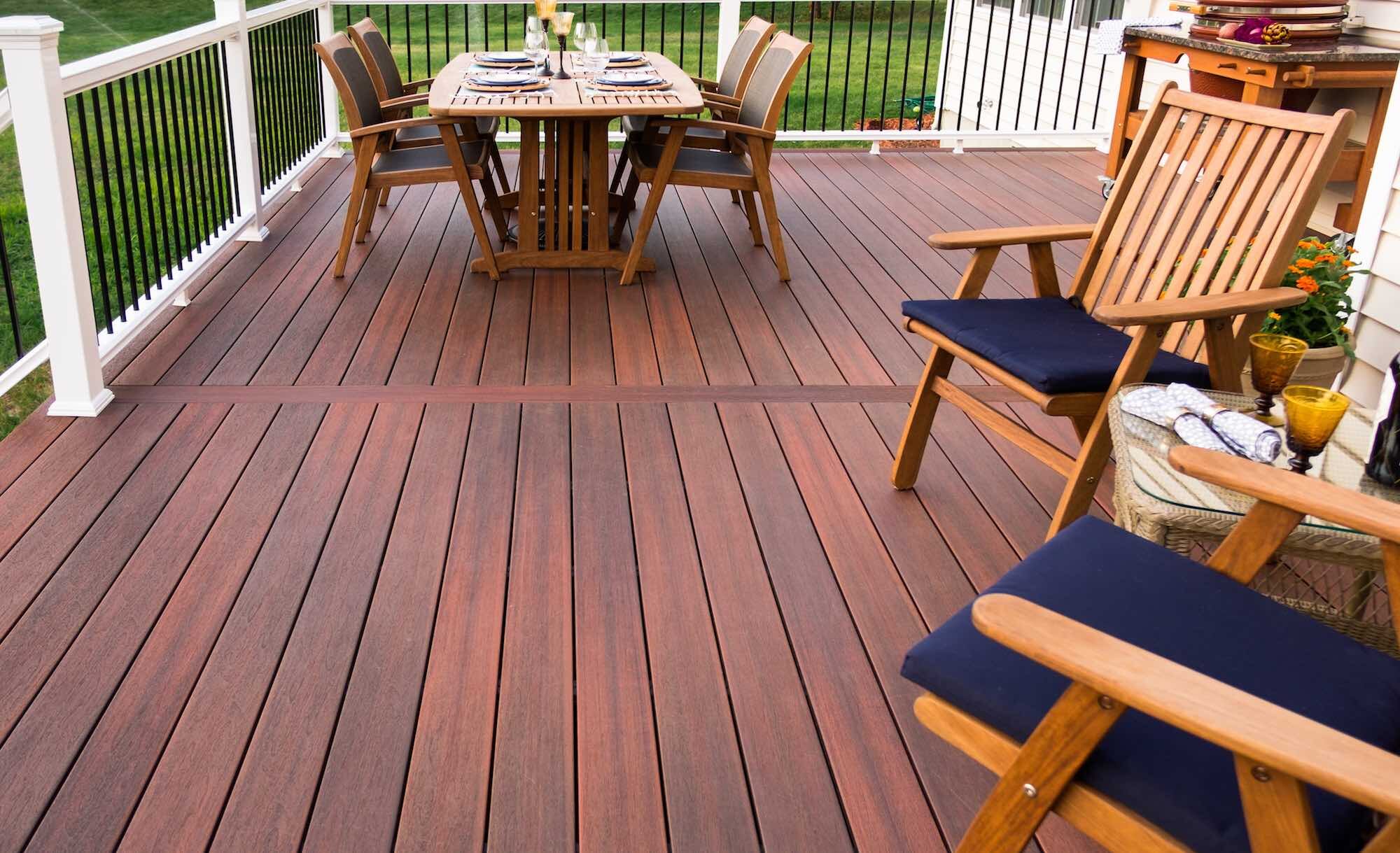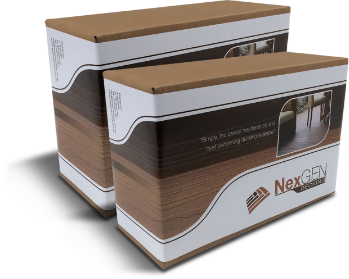If none of theses answers your question, please don’t hesitate to call us on 1300 661 801 or contact us.
01 Composite Decking FAQ's
What is it made of?
NexGEN Decking is crafted from 50% recovered hardwood fibre and 50% UV-stabilised high-density polyethylene.
Where is it made?
In USA by Fiberon Composites with patented technology.
What are the advantages over traditional timber decking?
Long straight lengths, quick and easy installation, never warps, never rots, splinter free, no sanding, no painting, no sealing, no staining, long lasting, scratch resistant, termite resistant and up to a 50 Year, Stain and Fade Warranty.
What maintenance is required?
Virtually none, only occasional cleaning with soap and water or a pressure clean.
How does NexGEN compare to other composite decking?
NexGEN Decking products are the only ones on the market that solves the three problems composite decking customers complain most about: colour fade, staining, and mould/mildew. Each board has a non-porous surface layer that is co-extruded into the wood fibre (golf ball cover technology). The nonporous cover is what sets our boards apart from all other composites.
Will the surface peel or wear off?
The surface will not peel off due to the fact that the surface layer is coextruded into the wood fibre. Under normal conditions, the surface will last indefinitely. If exposed to high wear or abrasion, some wearing is possible. If any of the substrate becomes exposed, this is no cause for alarm because it contains the same UV stabilizers as the rest of the composition and is not affected.
How long will the antimicrobial product protection last?
Antimicrobial protection is built-in during the manufacturing process and will not wash off or wear away. It is engineered to provide continuous antimicrobial product protection for the useful lifetime of the product.
How does the price compare to traditional timber decking?
Our pricing is similar to a good quality hardwood but of course you will end up saving money each year due to the maintenance requirements of timber.
What sort of warranty is there?
Lifetime performance warranty to a 50 year Stain, Fade and Performance Warranty on our Select Range.
How is it fixed?
Each board is pre-grooved on both sides to take a hidden fastener system.
How does temperature affect the boards?
NexGEN deck boards are suitable for all climates and are sold all over the world where harsh freezing winters and boiling hot summers have put them to the test.
Are they slippery when wet?
No more slippery than normal timber.
Can I paint or stain the boards?
Only cut edges will respond properly to matching stains or quality oil based paint.
Can you DIY?
Yes it is very DIY friendly and our team is available to assist with any questions.
Do I need special tools to cut it?
No it cuts like normal hardwood.
02 Aluminium DryDeck FAQ’s
Will DryDeck aluminium deck boards get hot during the summer?
Aluminium’s high thermal conductivity dissipates heat, providing a cooler deck surface than most wood or composite surfaces.
What colours are available?
DryDeck aluminium decking is available in three colours – Granite, Artisan Clay and Sandstone.
Will outdoor exposure cause DryDeck to weather or fade? Is routine maintenance involved to keep my deck looking new?
DryDeck will not age; fade or “weather” like alternative decking materials. It is naturally UV-resistant decking— not subject to the deteriorating effects of direct sunlight and will not splinter, decay or rot. DryDeck meets or exceeds international standards. Additionally, since DryDeck is decking made with aluminium, it is impervious to insects and termites plus the non-porous surface is naturally resistant to fungi, mould and mildew. With DryDeck aluminium deck boards, there’s no time or money spent on routine maintenance like sanding, painting, staining, sealing, or waterproofing. Just years of enjoyment on a deck you will be proud to show off!
Is the aluminium decking slippery?
No. DryDeck aluminium decking is not slippery. It has a powder-coated finish that provides steady footing in wet or dry conditions. Additionally, the ribbed surface provides additional traction and conceals the hidden fasteners system for a gapless surface.
Will my DryDeck ever rust?
DryDeck is extruded from a pure aluminium alloy that cannot rust. However, as with other decking materials including wood, composite, or even concrete, steel products that come in contact with DryDeck can rust and even stain DryDeck. Do not store metal objects that could rust and stain your deck on DryDeck. Avoid metal working on DryDeck too. When installing railings, protect DryDeck with a non-plastic drop cloth to prevent grinding dust and weld splatter from settling on the surface of DryDeck.
Do I have to pitch DryDeck?
Yes, we suggest minimum pitch of 1 in 100. This is a minimal pitch that will not be visible to the naked eye but provides a generous slope for water to drain away from the structure.
Do I need special tools to install DryDeck?
No. DryDeck can be installed with a minimum number of readily available tools. No special tools are necessary for installation.
Can I cantilever DryDeck? Is there a suggested overhang?
DryDeck is a maintenance free decking product – these interlocking deck boards create the surface for your deck. And since it is a deck board it cannot be cantilevered – deck boards should never be cantilevered. A 50mm overhang beyond the fascia on the drainage side is suggested to shield the joists from backsplash due to heavy downpour and ease optional gutter installation.
Are the DryDeck waterproof deck boards compliant with local building codes and International Building Codes?
Yes. DryDeck meets or exceeds deck building code specifications and guidelines for aluminium structures, as recommended by International Building Codes.
My deck frame was built using ACQ (Alkaline Copper Quaternary) pressure treated wood, is it compatible with DryDeck aluminium decking boards?
Yes, DryDeck was designed to be compatible with ACQ treated lumber. It is produced with a barrier coating (a special powder-coat paint applied at the mill) to prevent ACQ contact with the bare aluminium.
Do I have to install gutters or downpipes?
Installing gutters or downpipes is not required, although they can be installed if you would like to incorporate your deck with your landscape architecture and design.
Can DryDeck be used for the deck joists?
No, DryDeck can not be used as a component as a truss, structural framing applications for joists, rafters, or support beams. DryDeck should solely be used for deck flooring. It just happens to be watertight deck flooring.
What type of blade should I use to cut DryDeck?
Carbide-tipped non ferrous blade 12” blade-96 tooth, 10” blade 80 tooth, 7 ¼” blade 62 tooth (available at local building supply stores.)
What are the joist spacing requirements when installing DryDeck aluminium decking?
The maximum allowable joist spacing is 600mm on-centre when installing the aluminium deck boards on pre-existing or new joist structures.
How much does DryDeck weigh?
DryDeck Aluminium Deck Boards weigh 1.5kgs per linear metre (approximately ½ the weight of traditional wooden deck boards)
03 DryJoist FAQ’s
How does DryJoist differ from other waterproof deck systems?
DryJoist is a structural deck drainage system; this means that along with being 100% waterproof, it also replaces the conventional deck joist system you would traditionally use to build your deck.
Other waterproof deck systems on the market are either membrane systems or “under decking” type systems that are installed below your deck joists. Both of those waterproof deck systems come with highly labor-intensive installation processes and are only effective for limited amounts of time.
The component materials used in the DryJoist system are extruded from marine-grade aluminum, which makes them very rigid and extremely durable. When the DryJoist system is installed, it provides a solid waterproof structure that will never leak. Additionally, DryJoist is mounted on top of your deck frame, which extends the life of framing materials.
What types of applications can DryJoist be used for?
DryJoist can be installed by a professional deck builder or the DIY homeowner. DryJoist can be used to build, refurbish or remodel a multitude of outdoor structures such as a:
- Backyard deck
- Second story balcony
- Patio or Porch
- Roof deck or Pool deck
- Walkout carport
- Garage deck
DryJoist is a simple and single structural deck waterproofing system. It is also the first of it’s kind decking system to provide both structural support for the deck’s surface boards, while creating a 100% dry living space below deck. Other applications include landscape architecture such as water harvesting or even a deck cover for outdoor kitchens.
What type of deck boards can I use with DryJoist?
DryJoist provides the ultimate flexibility, with no limitations when it comes to your deck surface options. Obviously we would love you to install our capped composite decking boards onto DryJoist however your choices are almost limitless. In essence, DryJoist has support every 100 to 150mm which allows you to fasten your deck boards every 100/150/200/250/300mm.
Is DryJoist environmentally friendly?
Yes. DryJoist is manufactured using 45% recycled content from industrial and post-consumer aluminium scrap. DryJoist also harvests rainwater—reducing pollution from stormwater runoff. Because of the recycled content and the stormwater management, DryJoist is an environmentally-friendly decking product. As such, this product also assists builders in achieving points toward LEED credits based on the standards set forth by the LEED Green Building Rating System.
Do I need special tools to install DryJoist?
No. DryJoist can be installed with a minimum number of readily-available tools. No special tools are necessary for installation.
Do I have to pitch DryJoist?
Yes, we suggest approximately a 1 in 100 downward pitch (away from the house). This is a minimal pitch that will not be visible to the naked eye, yet provides a generous slope for water to drain away from the structure.
Is the DryJoist structural deck drainage system compliant with local building codes and the International Building Code?
Yes. DryJoist meets or exceeds deck building code specifications and guidelines for aluminium structures, as recommended by International Building Codes.
Can I cantilever DryJoist? Is there a suggested overhang?
Yes, the maximum allowable edge cantilever for DryJoist is 300mm. A 50mm overhang beyond the header joist on the drainage side is suggested to shield the joists from backsplash due to heavy downpour and ease optional gutter installation.
Can I use hidden fasteners when installing my deck boards on DryJoist?
Yes. Follow the manufacturer’s guidelines for the correct hidden fastener method when installing your preferred decking surface boards.
What type of blade should I use to cut DryJoist?
It is recommended to use either a mitre or circular (skill) saw with a carbide blade: 300mm blade – 96 teeth / 250mm blade – 80 teeth / 180mm blade – 62 teeth. Saw blades with fewer teeth stay cooler, last longer, and are typically easier to use.
Do I have to install gutters or downpipes?
Installing gutters or downpipes is not required, although they can be installed if you would like to incorporate your deck with your landscape architecture and design.
Products
Gallery
Contact
Direct Office Numbers
Adelaide – (08) 6316 0469
Brisbane – (07) 3041 6065
Sydney – (02) 8072 6220

